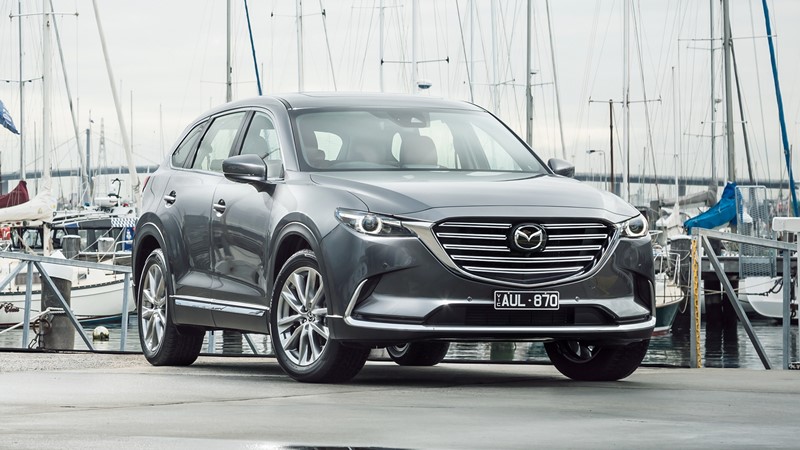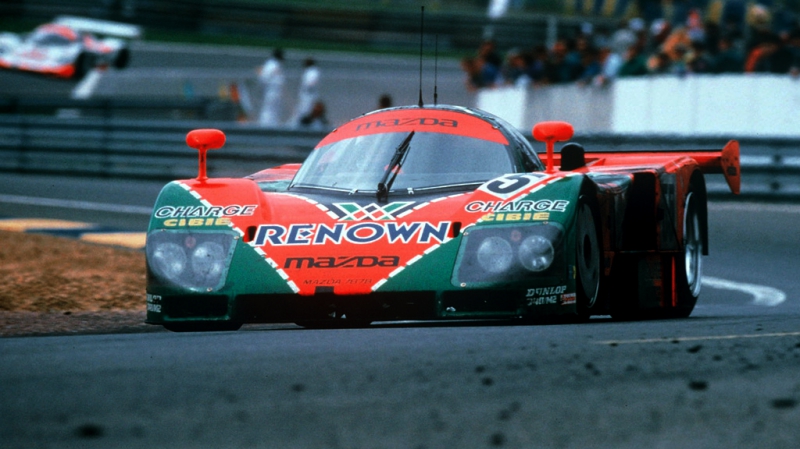The Japanese bubble-era of 1986 to 1991 was one of the great defining moments in automotive history. It was the era that inflated the Japanese economy with so much spending power that the Japanese car companies threw caution to the wind and carried out some truly stunning engineering feats. Feats like the original Lexus LS, the Honda NSX, and the Subaru SVX were genre-defying cars that would never have gotten a chance in any preceding era, or in any other era that followed.
Like any bubble, the boom times were short-lived and when it went bust the grand illusion disappeared in a blink of an eye. As the Nikkei lost nearly half its value within a year and land prices cratered, those ambitious projects that failed to get out the door were quickly axed, and one such project that nearly saw the light of day was Mazda’s own luxury brand, Amati.

While everyone is familiar with how Toyota blew everybody’s minds with the quality and engineering of the 1989 Lexus LS400, Mazda was working on a new Amati-branded luxury sedan in 1991 that was to be equipped with a 4-litre W12 made from aluminium, magnesium and ceramic components, which would have made the LS look as sophisticated as a bullock cart. If Japan’s bubble had held together for a few more years, who knows, maybe there would be four upmarket Japanese brands instead of three. In retrospect, maybe that was for the better.
Jump forward to today and so far Lexus is the only one of the three Japanese luxury brands who has successfully carved out a distinctive brand identity and presence. Its success is largely thanks to Toyota’s vast resources, engineering prowess, and brilliant market knowledge, which has helped it chart a course where Infiniti lost its direction and Acura its distinct identity. Who knows how Mazda’s Amati would have fared. Considering that Mazda never had the resources of Japan’s Big Three – even during the boom times – chances are it wouldn’t have ended well.

Even as the Japanese economy has yet to return to a period of excess like that of the 1980s bubble-era, reports have it that Mazda are setting its sights on stepping into the premium brand arena, not by means of creating a spin-off brand like their stillborn Amati or Hyundai’s Genesis, but with the Mazda brand itself.
In 2017 Mazda had outlined its desire to move its brand upmarket with what they define as the “Mazda Premium” strategy. The first step in its strategy was said to be seen in the second-generation CX-5, and at last year’s Los Angeles Auto Show Masahiro Moro, president and CEO of Mazda’s North American Operations, said that the new seven-seater CX-9 had kicked its upmarket move into “high gear” with more than half its owners cross-shopped the CX-9 against models from “luxury and premium brands”. In an article on Carlist.my, Mazda North America clarifies their statement of “luxury and premium brands” as Audi, Volvo, and the three Japanese luxury brands in North America.

It isn’t just North America where such aspirations are expressed by the brand. Over in Australia, Mazda had stated a similar intent, with the fourth-generation Mazda 3 copping a 20 per cent price hike over its predecessor, and this isn’t the model that comes with the model’s headlining new SkyActiv-X compression ignition engine, which is expected to command a further premium when it arrives later in the year.
Mazda Australia attributes its decision of moving its price window up to customer trends for more bells and whistles, which is reflected on the new Mazda 3’s equipment offerings that features a generous helping on new driver aids and swank new toys. The company is adamant on focusing on private owners rather than fleet buyers, even if it means that they will sell less examples than its predecessor. Will it work? Well Mazda Australia doesn’t need to look far for cautionary tales.

As it turns out Honda tried a similar move in Australia more than a decade ago with detrimental results. From a high of more than 60,000 annual sales in 2007, Honda Australia’s sales performance declined by more than half by 2011, which some pundits attribute to bad product and pricing decisions that turned customers off and whittled away much of the brand’s goodwill with consumers. These missteps from a once respected brand were driven by Honda’s ambition to project themselves as a ‘premium brand’, which sadly landed them in a prolonged period of malaise that they are only just beginning to recover from.
The lure of the ‘premium market’ is understandable. It is a market where there is a huge potential for fatter profit margins, which might be a prudent move for carmakers who are building mainstream products, particularly for cars in the compact and small car segment where recent demands for active driver assistance and onboard features similar to those in premium offerings have driven up development costs to unsustainable levels. The industry knows that the business model of small mainstream cars is a sinking boat, and the only way to survive is to climb the mast and reach for the sky.

The inherent risk of going upmarket is that without the right product all this effort will come off as disingenuous and alienating to mainstream buyers. Like a truant pupil declaring themselves to be a savant and telling the principal to eat a fat one only to land a career that earns prison sentences, it is all potentially schadenfreude and one that adequately describes Honda’s downfall in Australia. Customers are not easily swayed by claims that have no product merits to back it up, and in this case, Honda’s own attempt coincided with a time of global upheaval in engine technologies that left them void of the right products to match their intent. Where Honda continued to push mild-hybrids they stood little chance against brands like Volkswagen who were winning hearts with their newer – and more exciting – turbocharged engines and dual-clutch transmissions.
In this respect, Mazda might have a trump card in the form of the upcoming SkyActiv-X engine, which Mazda hopes will reinvigorate interest in internal combustion engines as plug-in hybrids and full-electric cars are growing in popularity. Adding to that, part of Mazda’s overall strategy has largely been design-driven with their successful Kodo design language, which has produced some truly tasteful creations such as the third-generation 6 sedan, second-generation CX-5, and fourth-generation MX-5, all of which has excelled in raising the brand’s profile.

Despite its product offensive Mazda still is a relatively tiny car maker that doesn’t have the luxury of near-limitless resources Japan’s Big Three wields and is punching well above it weight at this point. However, what Mazda lacks in resources it more than makes up for it with spunk, and its grand ambitions are reflective of another rags-to-riches success story, BMW.
Looking at the German giant today it is easy to forget that their venture into the automotive business started out as a maker of motorcycles and licensed communist cars, which many thought wouldn’t amount to anything significant and the whole operation was nearly peddled off to Daimler-Benz. Industrialist Herbert Quandt stepped in to save the company from a buyout and picked Eberhard von Kuenheim, in 1970 to change its fortunes.

Kuenheim who served as chairman till 1993, saw that in order for a small car maker such as themselves to succeed they had to gun for the premium sector. And gun it did. With a range of distinctive products and motorsports activities that garnered a strong and loyal following amongst enthusiasts, the Bavarian name soared in its standing, surpassing its superiors of the time, Alfa Romeo and Volvo, and becoming a proper rival to Mercedes-Benz in both sales and brand value.
To the more observant, there are many notable parallels to be drawn between Mazda’s current circumstances and BMW’s formative years. Mazda has several distinctions in motorsports to its name, most notably being the first – and only for 27 years – Japanese car maker to win Le Mans, whereas the MX-5 is often touted as “the most raced car in the world”. As demonstrated at the start of this piece with the Amati, and the company’s dogged determination for the rotary engine, Mazda’s own history bears the right narrative of a company being defined by its daring engineering exploits, much like how BMW’s own 8 Series and its love for straight-six engines had endeared itself to enthusiasts around the world.

When it comes to brand image Mazda, like BMW, has latched onto the creed of designing everyday cars with qualities that drivers would appreciate. Even their marketing tagline, “Zoom-Zoom” is very similar in its thematic message and worldwide recognition as BMW’s “Ultimate Driving Machine”.
The only thing that Mazda can’t do is be European, the seemingly unspoken requirement – amongst snobs – to be considered part of the premium club, though the tides may change. Early-90s Japanese sports cars are already beginning to command large sums, which in turn has burnished the desirability of Japanese makes to a point where a brand new and untested Supra could command more money at auction than a brand new 500kW Mustang.

In a previous post here not too long ago, it has been suggested that the production of SkyActiv-X engines would be the brand’s greatest gamble. While at a product level it is no less audacious, the fate of an engine would do little more than sink profits.
By comparison, Mazda is risking it all for a shot at redefining itself. They don’t have an unrealistically-inflated home economy to bankroll them as Lexus, Infiniti, and Acura had in the late-1980s, but even so, by playing their cards right through engineering and design

